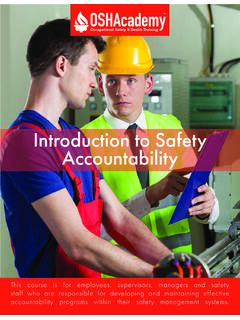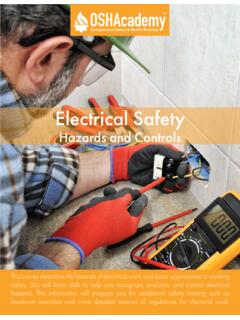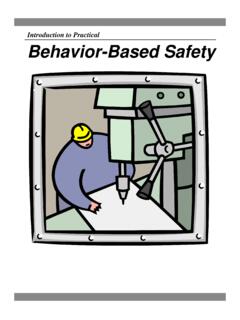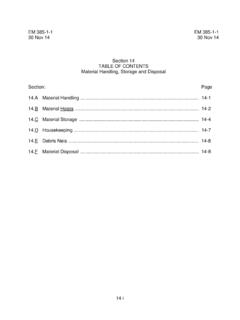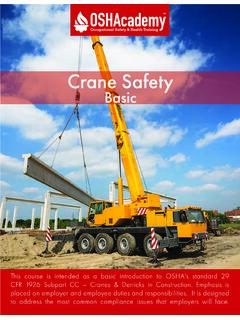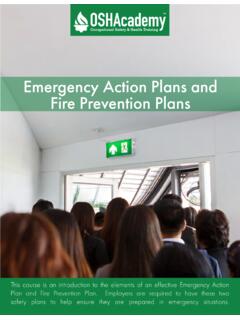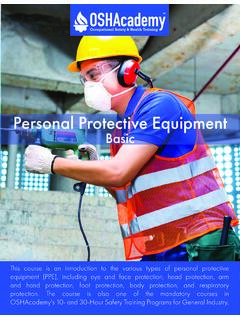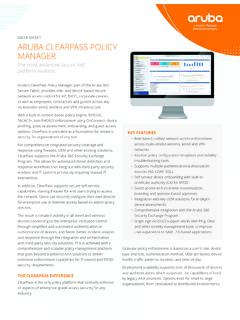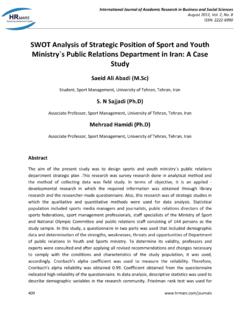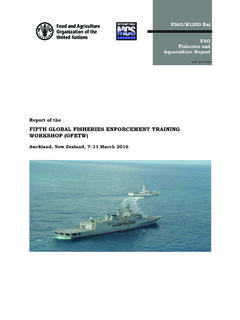Transcription of 716 Safety Management System Evaluation - OSHAcademy
1 The Safety and Health Management System is extremely important to the long-term success of an organization. This course will introduce you to the Safety and Health Achievement Program (SHARP) Audit process by discussing an audit process similar to that used by OSHA evaluators. Even if your company doesn't anticipate participating in the SHARP program, the information within this online course is vital in your efforts to improve the quality of your Safety Management Management System EvaluationCourse 716 This page intentionally blank Course 716 OSHA cademy Course 716 Study Guide Safety Management System Evaluation Copyright 2022 Geigle Safety Group, Inc. No portion of this text may be reprinted for other than personal use.
2 Any commercial use of this document is strictly forbidden. Contact OSHA cademy to arrange for use as a training document. This study guide is designed to be reviewed off-line as a tool for preparation to successfully complete OSHA cademy Course 716. Read each module, answer the quiz questions, and submit the quiz questions online through the course webpage. You can print the post-quiz response screen which will contain the correct answers to the questions. The final exam will consist of questions developed from the course content and module quizzes. We hope you enjoy the course and if you have any questions, feel free to email or call: OSHA cademy 15220 NW Greenbrier Parkway, Suite 230 Beaverton, Oregon 97006 + Disclaimer This document does not constitute legal advice. Consult with your own company counsel for advice on compliance with all applicable state and federal regulations.
3 Neither Geigle Safety Group, Inc., nor any of its employees, subcontractors, consultants, committees, or other assignees make any warranty or representation, either express or implied, with respect to the accuracy, completeness, or usefulness of the information contained herein, or assume any liability or responsibility for any use, or the results of such use, of any information or process disclosed in this publication. GEIGLE Safety GROUP, INC., DISCLAIMS ALL OTHER WARRANTIES EXPRESS OR IMPLIED INCLUDING, WITHOUT LIMITATION, ANY WARRANTIES OF MERCHANTABILITY OR FITNESS FOR A PARTICULAR PURPOSE. Taking actions suggested in this document does not guarantee that an employer, employee, operator or contractor will be in compliance with applicable regulations. Ultimately every company is responsible for determining the applicability of the information in this document to its own operations.
4 Each employer s Safety Management System will be different. Mapping Safety and environmental Management policies, procedures, or operations using this document does not guarantee compliance regulatory requirements. Revised: January 3, 2022 Course 716 This page intentionally blank Course 716 Contents Course Introduction .. 1 Course Goals .. 1 Module 1: Safety Management System (SMS) Basics .. 2 Introduction .. 2 Safety Management Systems Structure .. 3 Safety in an Organization .. 3 Safety Manager (SM) .. 3 Safety Engineer (SE) .. 4 Human Resource Manager/Coordinator .. 5 Safety Committee (SC) .. 6 All Systems Behave .. 7 Quality In: Quality Out .. 8 What does this principle mean? .. 9 Module 2: Analyzing the SMS .. 10 Introduction .. 10 Step One: Analyze the System with a Baseline Survey.
5 10 Step Two: Narrow the focus - Analyze Each SMS Component .. 11 Step Three: Conduct Cause Analysis .. 12 Surface Symptoms .. 13 Underlying Root Causes .. 14 System Design Weaknesses .. 14 System Performance Weaknesses .. 14 Course 716 Module 3: Cause Analysis .. 16 Documentation .. 16 Interviews .. 16 Review Workplace Conditions .. 17 The "5 Whys" Technique .. 18 Cause and Effect (Fishbone) Diagram .. 19 Cause and Effect Fishbone Diagram Procedures .. 20 Module 4: Evaluating the SMS .. 22 What is " Evaluation .. 22 Focus of an SMS Evaluation .. 23 Purpose - Fix the System , Not the Blame .. 24 Safety Committees Should Help Evaluate the SMS .. 25 Determine the 25 A Simple Evaluation .. 26 Analysis: What does it look like? .. 26 Evaluation : OK, how "good" is the apple? .. 26 Cause Analysis: OK, what's the cause?
6 26 Evaluating the Safety Management System .. 27 Example .. 29 Evaluating the Safety Management System .. 29 Scenario .. 30 Results .. 30 Module 5: The Safety & Health Achievement Recognition Program (SHARP) .. 32 Introduction .. 32 Course 716 How You Can Participate In SHARP .. 32 SHARP Certification and Inspection 33 Not Quite Ready for SHARP? .. 34 The SHPA Worksheet .. 35 Evaluating Attributes .. 36 Rating the Attributes - Analyzing the Cues .. 37 Module 6: The Voluntary Protection Program (VPP).. 40 Benefits .. 40 Three Levels of Participation .. 40 Three Categories of Participation .. 41 VPP Corporate .. 42 The VPP Safety and Health Management System .. 43 The Four Elements of the VPP Safety and Health Management System .. 43 Guiding VPP Principles .. 44 VPP Recognition.
7 45 VPPPA .. 46 Course 716 This page intentionally blank Course 716 Copyright 2022 Geigle Safety Group, Inc. Page 1 of 47 Course Introduction In this course, you will learn how to identify, analyze and evaluate your company's Safety & Health Program. With the advent of the systems approach to Safety Management , Safety professionals are increasingly calling their comprehensive Safety program a " Safety Management System (SMS)." This is the term you will see throughout the course. Any reference to " System " refers to the SMS. The Safety and Health Management System is extremely important to the long-term success of your organization. This course will show you how to analyze and evaluate your Safety Management System by discussing the various steps in the process used by OSHA consultants to assess companies participating in the Safety and Health Achievement Program (SHARP) Evaluation process.
8 Even if you are company doesn't anticipate participating in this program, the information within this online course may be very helpful in your effort to improve your SMS. To better understand the concept of " System ," we'll review the four primary System components in every System . We'll also examine how an organization's Management structure, leadership style, and the resulting Safety culture impact the seven elements of a Safety Management System . Course Goals 1. Understand the following concepts: analysis, Evaluation , surface cause, root cause, and System . 2. Gain a better understanding of Safety and health programs as systems. 3. Learn about the SHARP Evaluation model as a tool to evaluate your Safety Management System . Course 716 Copyright 2021 Geigle Safety Group, Inc.
9 Page 2 of 47 Module 1: Safety Management System (SMS) Basics Introduction A " System " may be thought of as an orderly arrangement of interdependent activities and related procedures which implement and facilitate the performance of a major activity within an organization. (American Society of Safety Engineers, Dictionary of Terms) Take a look at Syssie, the cow. Syssie is a System , right? You can tell she's a cow, so she has "structure." She needs food, air, water, a suitable environment, tender loving care, and other "inputs" to function properly. We know she has respiratory, digestion, circulation, and many other "processes" inside. Finally, she produces outputs like milk, waste products, and behavior.
10 Just like Syssie, all organizational systems are composed of the same four basic components: 1. S tructure 2. I nputs 3. P rocesses 4. O utputs If a System does not have adequate structure, inputs, or processes, the outputs will not be those desired. Let's take a closer look at these components as they relate to the Safety Management System . 1. A _____ may be thought of as an orderly arrangement of activities and related procedures which implement and facilitate the performance of a major activity within an organization. a. program b. plan c. System d. process Course 716 Copyright 2021 Geigle Safety Group, Inc. Page 3 of 47 Safety Management Systems Structure The structure of an SMS can take many forms.
